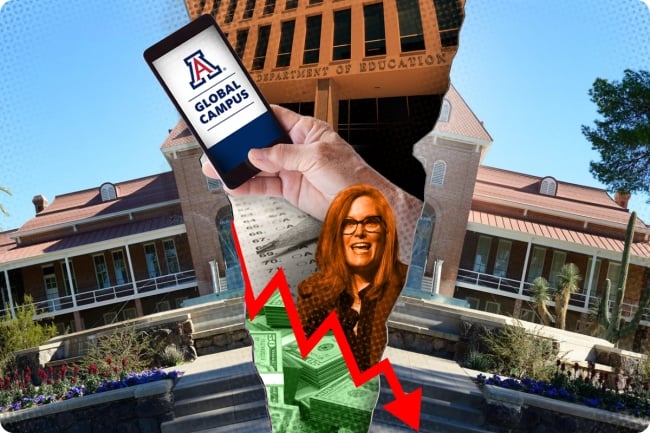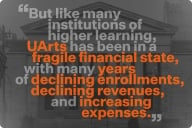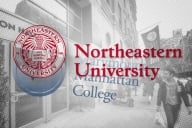You have /5 articles left.
Sign up for a free account or log in.

The University of Arizona is moving forward in a contentious consolidation deal with the University of Arizona Global campus.
The University of Arizona is moving forward with fully integrating its acquired online campus, a contentious consolidation that proponents argue could save the university millions of dollars. Others call it a financial mistake.
The university announced last week it would begin the “multi-year transformation” of fully folding in University of Arizona Global Campus. There is no target completion date given needed approvals from the Department of Education, the Arizona Board of Regents and Arizona’s accreditation agency, WASC Senior College and University Commission.
The announcement to move ahead follows an external, 12-week assessment from consulting firm Ernst & Young.
“These findings validate our vision,” said Gary Packard, UA’s senior vice provost of online initiatives. “Expanded online higher education enhances accessibility for people whose life circumstances might impede their ability to pursue a degree in person on campus.”
Previously known as Ashford University, the online-only UAGC became a unit of the University of Arizona in July 2023 after being acquired about three years before. Since then, the two have remained separate entities with their own accreditations. The integration of the online campus has been an ongoing drama full of budget woes and state government concerns.
The 43-page E&Y assessment, completed earlier this month, highlighted UAGC’s declining enrollment: the institution saw a 9 percent decline before UA’s acquisition and then a subsequent 14 percent decline.
However, the report stated that if enrollment reaches a “steady state” of 33,000 students, the university would save $12 million to $21 million annually. The report did not state how, or if, enrollment would be fixed.
Despite the numbers in the report, the University of Arizona does not see enrollment as a concern, as there is more focus on retention versus recruitment, according to a person at the university familiar with the integration. The person, who spoke on condition of anonymity, noted that the University of Arizona online program, simply dubbed UA Online, gains roughly 900 students every year and integrating that with UAGC’s roughly 23,000 students will “strengthen across the board.”
Aaron Lacey, chair of the higher education practice at the law firm Thompson Coburn, said that in situations like this, “someone is convinced, even though it’s losing money, if they bring it in market they can leverage it and bring more students in.”
Bringing the students under the UA umbrella alone could bolster enrollment, Lacey said.
Folding in UAGC had been on hold during the E&Y assessment, which originally stemmed from a letter to UA from Arizona governor Katie Hobbs, who expressed concerns about the acquisition.
“In addition to the financial concerns raised during the process, significant ethical problems with Ashford University’s business model appear to have been brushed aside by university leadership during the acquisition,” Hobbs wrote on Jan. 25.
A Good Idea?
The UA-UAGC integration goes beyond folding one entity into another. The combination comes at a time when lawsuits against some private entities are in full swing, for-profit online institutions—including UAGC—are accused of predatory practices, and higher education institutions struggle to stay afloat.
UAGC is not immune to those woes. More than two dozen former UAGC students, in an Arizona Republic article published Wednesday, said the school misled them about the cost and value of degrees, allegedly putting them on the hook for thousands of dollars with no job prospects in sight.
The University of Arizona source said that the article attempted to “broad brush University of Arizona Global Campus operations incorrectly” and repeatedly said the university has been “very intentional” in differentiating itself from Ashford, which became UAGC.
Hobbs had previously expressed concerns about the acquisition of Ashford, which she viewed as a failing entity with a bankrupt parent company, Zovio. After the deal, Zovio initially stayed on as an online program manager for the University of Arizona.
When the contract between Zovio and UA ended, the university did rehire 791 of the 909 Zovio employees, though university officials said C-suite and senior-level compliance officers were barred from reapplying.
Amber Villalobos, a fellow at the Century Foundation, said there needs to be a complete fresh start when acquiring an institution.
“If they truly want to bring [UAGC] into their purview, they would first need to really rid themselves of any remnants of Zovio,” she said. “And make sure all students are getting the same access to support and services. I’m not sure that’s happening right now. Can we really say UAGC is part of UA if that Zovio presence is still there?”
UAGC also comes with potentially millions in debt, first incurred as Ashford University. On March 4, the Department of Education warned the university it would be on the hook for the debt incurred by Ashford University students by way of discharged student loans, from before it was acquired and became UAGC.
The E&Y assessment of UAGC also mentioned the debt, stating, “UArizona acquired UAGC Corporation’s operations and assets for $1 and the assumption of substantially all of its liabilities (both current and future).”
Several experts said the potential gains with UAGC did not outweigh the known risks associated with the institution.
“It is true that UAGC is financially breaking even, but that is with a rapidly declining enrollment and therefore revenue base,” said Phil Hill, a market analyst and ed-tech consultant with Phil Hill and Associates. “This is a real liability, especially based on the California lawsuit against Ashford/UAGC and the subsequent U.S. Department of Education borrower-defense claim on UAGC.”
Mark DeFusco, a senior researcher at Higher Ed Consolidation Solutions who calls himself a “cheerleader for for-profit institutions,” said deals can be done well with the right partner, pointing toward neighboring Arizona State University and GSV Ventures.
But as for the University of Arizona and its global campus?
“This has to be the worst case study in the history of higher education,” he said. “From the very beginning, it’s been a completely flawed transaction, and they can’t keep up with themselves.”









